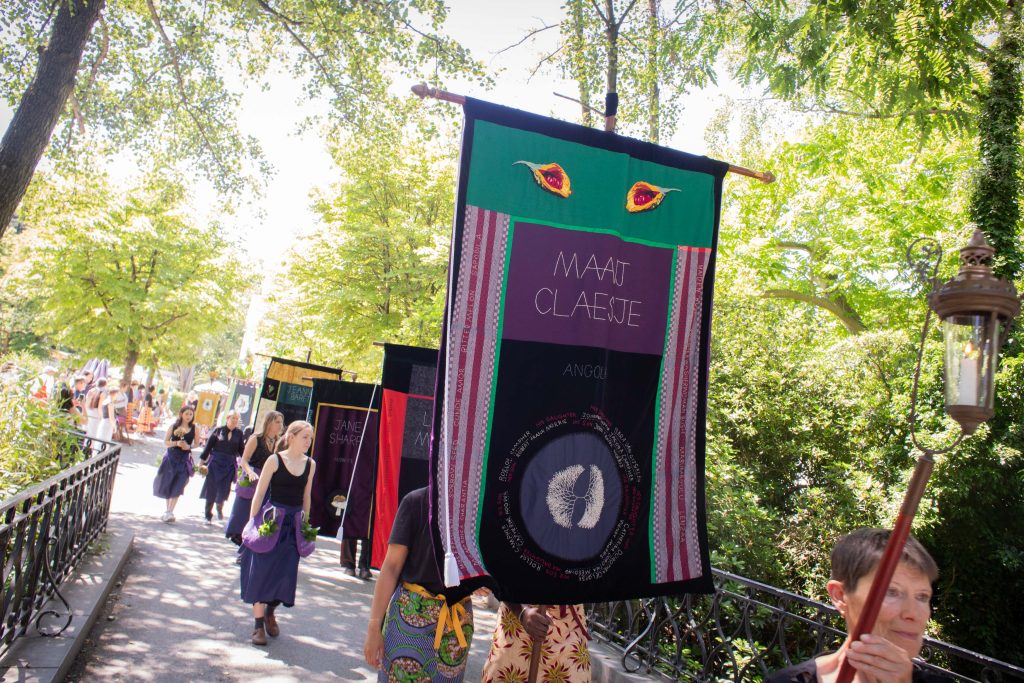
A journal entry and a proverb are brackets to the investigation:
1731. A Dutch VOC official at the Cape wrote in his journal: “December 31st, calm, settled weather. Nothing of importance occurred. An old slave woman, Maaij Claesje, died in the Slave Lodge”
UNESCO 1960. Malian intellectual Amadou Hampâté Bâ related an African proverb: “When an old person dies, it is a library burning to the ground”.
The investigation begins with gaps in the record.
On a family genealogy drawn up in the 1960s my father’s family was traced back to immigrants who arrived in the Cape in the 17th century. European immigrants were named. There were a few female ancestors listed as ‘unknown’. With the help of the First Fifty Years project that traces lives of the enslaved brought to the Cape in the 17th century, it was possible to trace the ‘unknowns’ or, rather, the intentionally forgotten, those actively written out of the record.

Further, I found three documents referring to my grandmother eleven-births-back, Maaij Claesje van Angola. The first document has her listed as one of the Angolan enslaved brought to the Cape aboard the Amersfoort in 1658. These captives, five hundred at the start of the voyage from Luanda, had been aboard a Portuguese slave ship heading for Bahia, Brazil. The ship was attacked by a Dutch VOC ship and two hundred and fifty of the captives were transferred to the Amersfoort and brought to the Cape. The second document, an entry in 1731 in the daghregister of a Dutch VOC official, refers flippantly to the death of Maaij Claesje and gave rise to the title of the project. A third set of documents reveals that Maaij Claesje, in 1689, was taken aboard the Wapen Van Alkmaar on its voyage from the Cape to Batavia, as midwife, to assist Geertruyd Chasteleyn with the birth of her child midway between the two ports. Maaij Claesje, it seems, successfully negotiated her emancipation in return for this service. On her return to the Cape she was listed as a ‘Free Black’. Later, for reasons uncertain, Maaij Claesje returned to the Slave Lodge. This last set of documents carries a suggestion – reading between the lines – that Maaij Claesje had a degree of agency due to her expertise as a midwife. This project sets out to recuperate what expertise that might have been and to find artistic form to make this visible and transmissible. Taking the lead from Amadou Hampâté Bâ, the project seeks to speculatively imagine, through investigation and analogy, the library that was Maaij Claesje.
First-hand narratives of enslaved lives and experiences at the Cape do not emerge from the written archives and alternative archives must thus be sought. In this project hysteries of plant medicinal uses are investigated as bodies of knowledge that might be revealing of the agency of an enslaved woman, a midwife, in the 17th century.
Midwives attended women in labour but also had expertise useful to those who did not wish to bring children into the world. Given what we have learned or must surmise of the experiences of enslaved women and coerced sexual relationships, it is not hard to speculate that plant remedies would have been sought as a clandestine means of achieving a measure of control over their own reproduction, and that a midwife might have been a key holder of such knowledge.

The focus of the project is, therefore, an inquiry into historical plant remedy practices for ‘women’s ailments’ – contraceptives, emmenagogues and abortifacients – that might have informed the practice of an enslaved midwife at the Cape. Through research into African, European and Asian hysteries of plant contraceptive uses, the project explores bodies of knowledge that would have flowed to the settlement at the Cape during time that Maaij Claesje was there, 1658-1731. The investigation attends to five streams of medicinal plant knowledge that would have merged at the Cape. The first would be from Angola, in the person of Claesje and others enslaved with her. The second would be from the Netherlands, through the bodies of Dutch women who accompanied their husbands to the Cape. The third from France, through Huguenot refugee women who migrated to the settlement. The fourth would be from South East Asia through the bodies of enslaved women taken to the Cape, and the fifth would have been medicinal plant knowledge already existent in the Cape through San, Khoi and Nama women living there. Contraceptive plant practices of enslaved African women in the Americas are – haphazardly – documented, unlike in the Cape, and so are investigated here as analogies that might prove insightful.
Working with female voices from the countries within the geography of the project (Angola, Brazil, South Africa, Indonesia, France, Netherlands, Portugal) a series of experimental polyvocal works – duets, songlines, clandestine radio pieces – are being composed and performed to make up the Herball for a Midwife.
Collaborations are established with ethnobotanists, anthropologists, healers of varying medicinal traditions, political scientists and historians of slavery whose work bring insights to the investigation. Through the chaplet series Fieldguides for a Preternaturalist, writings by these guides provide satellite texts that orbit the project.

Within these artistic-fictive constructions Maaij Claesje is conceived as an ancestor and spirit-being and is named midwif – from the ancient form of midwife denoting with woman. In the coming years a series of Travelogues are planned in which the Company will accompany !midwif from the hills of Cape Town to the hinterland of Angola, a return that will be part narrative, part physical journey, part audio songline.
Further description of the project